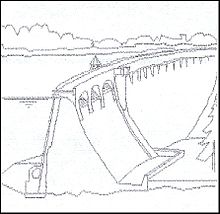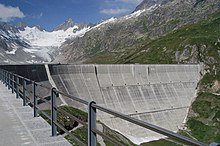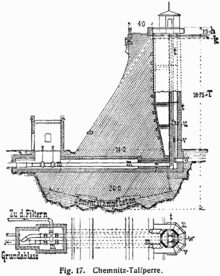Gravity dam
A gravity dam is a type of barrier structure for a dam , it consists of a heavy weight wall . This is built of concrete or masonry , in contrast to a dam , which consists of earth or poured stones. Gravity dams stand by their own weight, which also withstands the uplifting sole water pressure , whereas arch dams are supported by the support on the valley flanks. The cross-section of a gravity dam is roughly triangular with an almost vertical water side . The ratio of sole width to height is usually around 2: 3. Larger gravity dams generally have one or more inspection corridors in which there are drains and measuring instruments for monitoring.
Gravity dams are suitable in wide, less deep valleys with gently sloping valley flanks, while narrow valleys are more suitable for arch dams. You need good, stable building ground made of rock. A dam is preferred if the building site is unfavorable. The choice of the type of barrier also depends on the availability of the aggregate for the concrete or the filling and sealing material for a dam.
From 1890, many gravity dams in Germany were built from quarry stone masonry and according to the Intze principle . Almost all of them were arched in plan. The oldest gravity dam made of quarry stone masonry is the Eschbachtalsperre from 1891. After 1945, most of them were built from concrete and with a straight floor plan. The youngest gravity dam in Germany was built in 2005 in Thuringia ( Leibis-Lichte ). The oldest concrete gravity dam in Europe dams the water of Lake Pérolles in Freiburg / Friborg (Switzerland) and was completed in 1872.
Well-known examples
- Bleilochtalsperre and Hohenwartetalsperre (Thuringia)
- Grande Dixence (Switzerland, the highest gravity dam in the world, status 2010)
- Eckertalsperre ( Lower Saxony / Saxony-Anhalt )
- Möhnetalsperre ( Sauerland )
- Edertalsperre ( Hesse )
- Gottleuba dam ( Saxony )
- Eibenstock dam (Saxony)
- Rappbode Dam (Saxony-Anhalt)
- Janov dam ( Czech Republic )
- Leibis-Lichte Dam ( Thuringia )
- Mooserboden dam ( Salzburg )
- Three Gorges Dam ( China )
- Grand Coulee Dam ( USA )
- In den Schlagen dam (Switzerland)
- Oberaarsee (Switzerland)
- Räterichsboden dam (Switzerland)
Web links
- Talsperrenpraxis , at books.google.de


